CFD Simulation Study on the Air Side of a CO2 Evaporator in a Motor Train Unit Air Conditioning System
Abstract
:1. Introduction
2. CO2 Motor Train Unit Air Conditioning System
2.1. Characteristics of CO2 Refrigerant
2.2. Air Conditioning Refrigeration System Equipment
3. Calculation Model of Evaporator
3.1. Heat Transfer Calculation
3.2. Physical Model
3.3. Boundary Conditions and Grid Division
3.4. Simulation Reliability Verification
4. Analysis and Discussion of Simulation Results
4.1. Effect of Frontal Wind Speed on the Heat Transfer Performance of the Evaporator
4.2. Effect of Outer Diameter of the Heat Exchange Tube on the Heat Transfer Performance of the Evaporator
4.3. Effect of Fin Spacing on the Heat Transfer Performance of the Evaporator
5. Conclusions
- The simulation results are compared with the experimental values to calculate that the root mean square error of the resistance factor f is 0.88%, and the root mean square error of the heat transfer factor j is 0.31%. The simulation results are in good agreement with the experimental values, and the simulation results are reliable;
- The simulation results demonstrate that the cooling capacity of the CO2 evaporator in the system is up to 29.76 kW, which meets the heat exchange required in the air conditioning system of a motor train unit, and verifies the feasibility of the CO2 evaporator in the air conditioning system of a motor train unit;
- With the increase in air inlet velocity ve, the cooling capacity of the evaporator and the area optimization factor j/f value of the heat exchange tube are increased, and the heat transfer effect is improved. Taking into account the power consumption of the fan and a certain degree of superheat, a CO2 evaporator air-side inlet velocity between 1.4 m/s and 2.2 m/s can produce a better heat transfer effect;
- Appropriately reducing the diameter D of the heat exchange tube can reduce the wind resistance, raise the j/f value, and improve the refrigeration capacity of the evaporator; the wind resistance of the rear row tube is smaller than that of the front row tube and thus the structure of the front row small tube diameter and the rear row large tube diameter can be used to optimize the influence of wind resistance on the heat transfer effect of the evaporator;
- In a certain range, the change in fin spacing has no obvious effect on the air-side temperature drop. With the aggrandizement of fin spacing Fs, the turbulent motion in the flow channel can be fully developed, and the change in j/f has a peak value. The optimal fin spacing is between 1.6 mm and 1.7 mm, at this time, the average turbulent kinetic energy on the air side is larger and the turbulent dissipation rate is smaller.
Author Contributions
Funding
Data Availability Statement
Acknowledgments
Conflicts of Interest
References
- Qin, Y.; Yang, Z.; Wang, B.; Hao, Z.; Han, S. Research progress and development trend of new environmentally friendly refrigerants. Chem. World 2018, 59, 60–64. [Google Scholar]
- Liu, J.C.; Zhang, S.Y.; Zhou, Z.Y. Analysis of Channel Structure Improvement and Its Influence on Fluid Flow in Plate-fin Heat Exchanger. J. Mech. Eng. 2014, 50, 167–176. [Google Scholar] [CrossRef]
- Gao, J.; Ding, G.; Wu, W.; Gao, Q.; Song, J.; Liu, Z.; Chen, S. Design method of R290 air conditioner small tube diameter finned tube heat exchanger. China Aliance 2012, S1, 335–343. [Google Scholar]
- Liu, Z.; Fei, J.; Yang, Y. Study on the influence of pipe diameter on flow heat transfer in supercritical CO2 tubes. J. Eng. Thermophys. 2016, 37, 357–360. [Google Scholar]
- Fei, J.; Tian, S.; Wang, F.; Li, H. Optimization of structural parameters of straight finned tubular heat exchangers. J. Dalian Jiaotong Univ. 2018, 39, 40–44. [Google Scholar]
- Jiang, F.; Wang, Y.; Yu, B.; Wang, D.; Shi, J.; Chen, J. Effects of various operating conditions on the performance of a CO2 air conditioning system for trains. Int. J. Refrig. 2019, 10, 105–113. [Google Scholar] [CrossRef]
- Wang, Y.; Wang, D.; Yu, B.; Shi, J.; Chen, J. Experimental and numerical investigation of a CO2 heat pump system for electrical vehicle with series gas cooler configuration. Int. J. Refrig. 2018, 100, 156–166. [Google Scholar] [CrossRef]
- Zhang, H.; Li, J.; Zhao, F.; Huang, Y.; Fan, C.; Liu, H.; Yan, G. Matching characteristics of the refrigerant type to the diameter of the finned tube heat exchanger. J. Refrig. 2019, 40, 56–61. [Google Scholar]
- Ding, G.; Wu, G.; Liu, T. Research progress of refrigeration and air conditioning heat exchanger (1)—Small diameter finned tube heat exchanger. J. Aliance Sci. Technol. 2019, 4, 40–45. [Google Scholar]
- Li, K.; Zheng, Q. Numerical simulation study of the optimal number of rows for small heat pipe heat exchangers. Build. Energy Environ. 2020, 39, 41–45. [Google Scholar]
- Kim, M.H.; Pettersen, J.; Bullard, C.W. Fundamental process and system design issues in CO2 vapor compression systems. Prog. Energy Combust. Sci. 2004, 30, 119–174. [Google Scholar] [CrossRef]
- Chen, G.; Bai, G.; Pang, X.; Xu, J.; Zhao, J.; Tao, G.; Wu, S.; Cao, J. Research and realization of CO2 working fluid alication of high-speed EMU air conditioner. Foreign Railw. Locomot. Mot. Car 2021, 5, 8–14. [Google Scholar]
- Zhang, X. Thermal Foundation; Higher Education Press: Beijing, China, 2015; pp. 344–356. [Google Scholar]
- Zhang, C.L. Fundamentals of Vapor-Compression Refrigeration and Air-Conditioning System Modeling; Chemical Industry Press: Beijing, China, 2013; pp. 77–107. [Google Scholar]
- Han, Z.; Wang, G. Fundamentals of Engineering Fluid Mechanics; Beijing Institute of Technology Press: Beijing, China, 2016; pp. 262–289. [Google Scholar]
- Liu, N.; Li, H.; Shan, X.; Jin, X. Numerical simulation of air-side heat transfer and flow characteristics in shutter finned tube heat exchangers. Therm. Power Eng. 2021, 36, 70–77. [Google Scholar]
- Peng, J.; Zhang, Y.; Xu, Y.; Yang, R.; Yuan, L.; Li, S. Optimization of Staggered Fins Heat Exchangers for Miniaturized Hydraulic Power Units Using Genetic Algorithm. J. Mech. Eng. 2021, 57, 49–57. [Google Scholar]
- Christian, L.; René, R. Multi-objective design optimization of a rail HVAC CO2 cycle. Int. J. Refrig. 2018, 92, 133–142. [Google Scholar]
- Liu, B. ANSYS Fluent 2020 Comprehensive Alication Case Study Details; Tsinghua University Press: Beijing, China, 2021; pp. 45–72. [Google Scholar]
- Wahiba, Y.; Mohamed, G.; Evgueniy, E. 3D CFD study of the effect of inlet air flow maldistribution on plate-fin-tube heat exchanger design and thermal–hydraulic performance. Int. J. Heat Mass Transf. 2016, 101, 527–541. [Google Scholar]
- Wang, J.; Wang, X.; Zhu, Q.; Zhao, Y. Flow and Heat Transfer Characteristics of Flow Past the Bluff Body in Turbulent Boundary Layer. J. Mech. Eng. 2015, 51, 168–176. [Google Scholar] [CrossRef]
- Tian, S. The Optimization Design and Simulation of Heat Exchanger on Air Conditioning of Rail Transport. Master’s Thesis, Dalian Jiaotong University, Dalian, China, 2018. [Google Scholar]
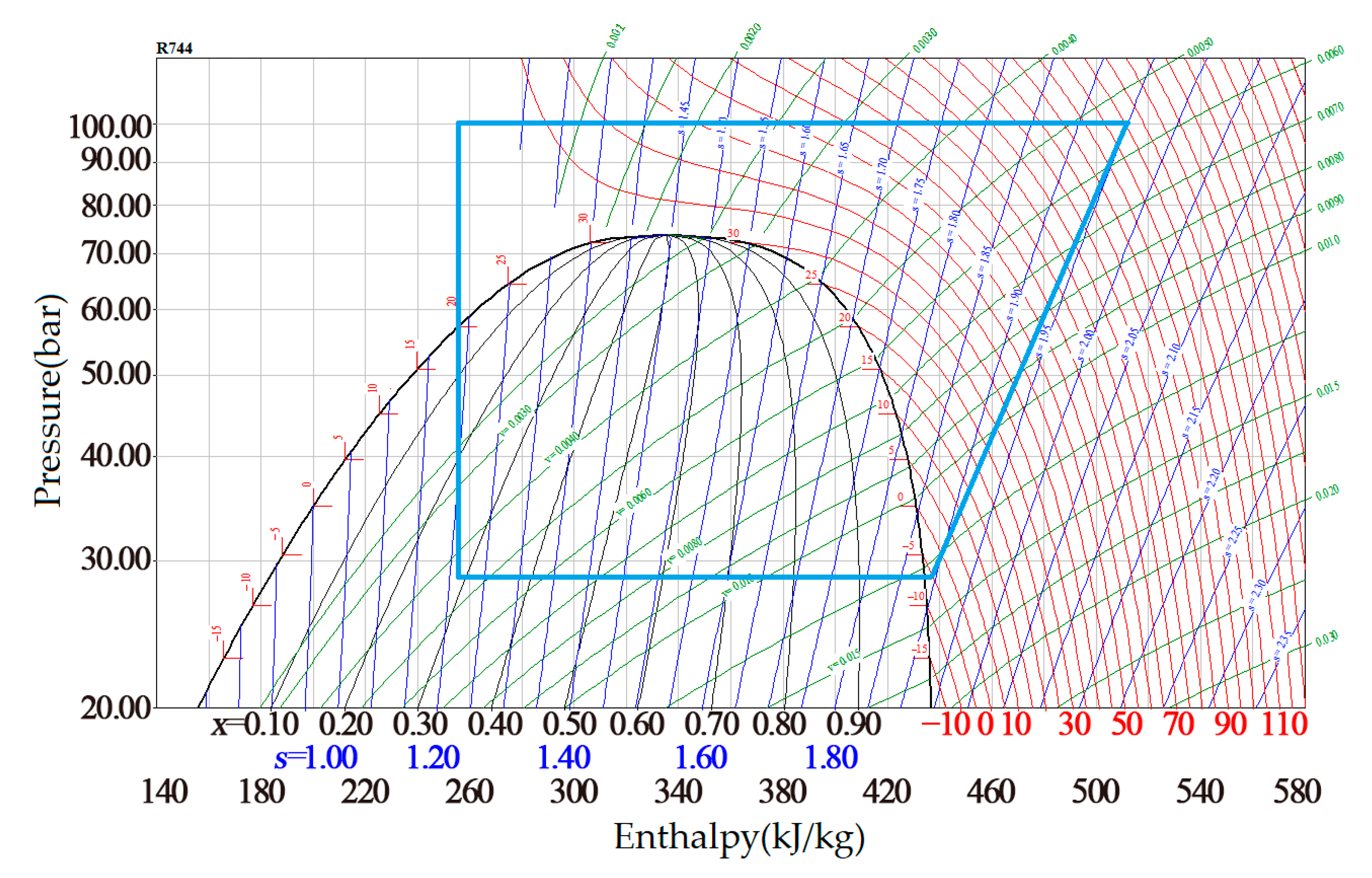
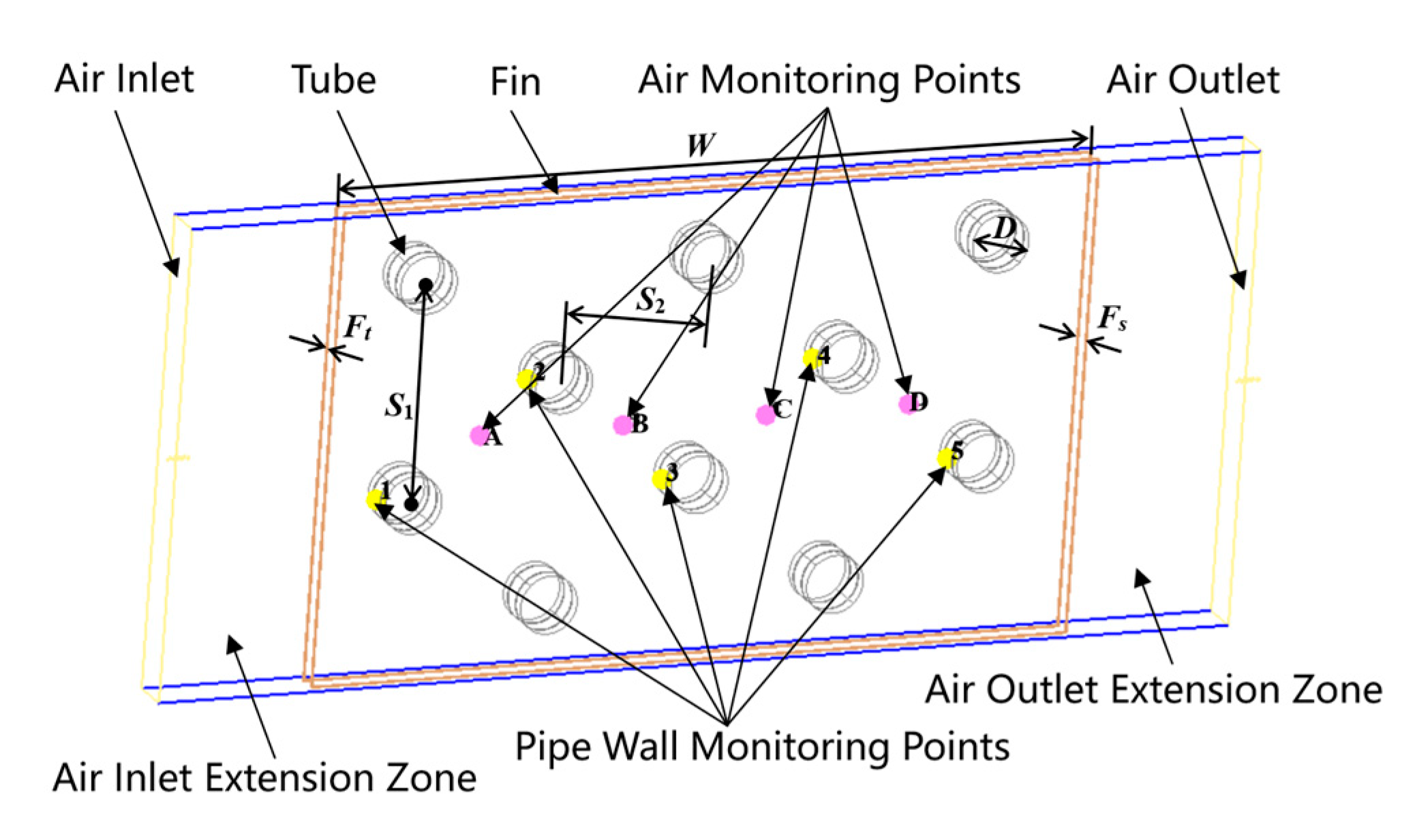

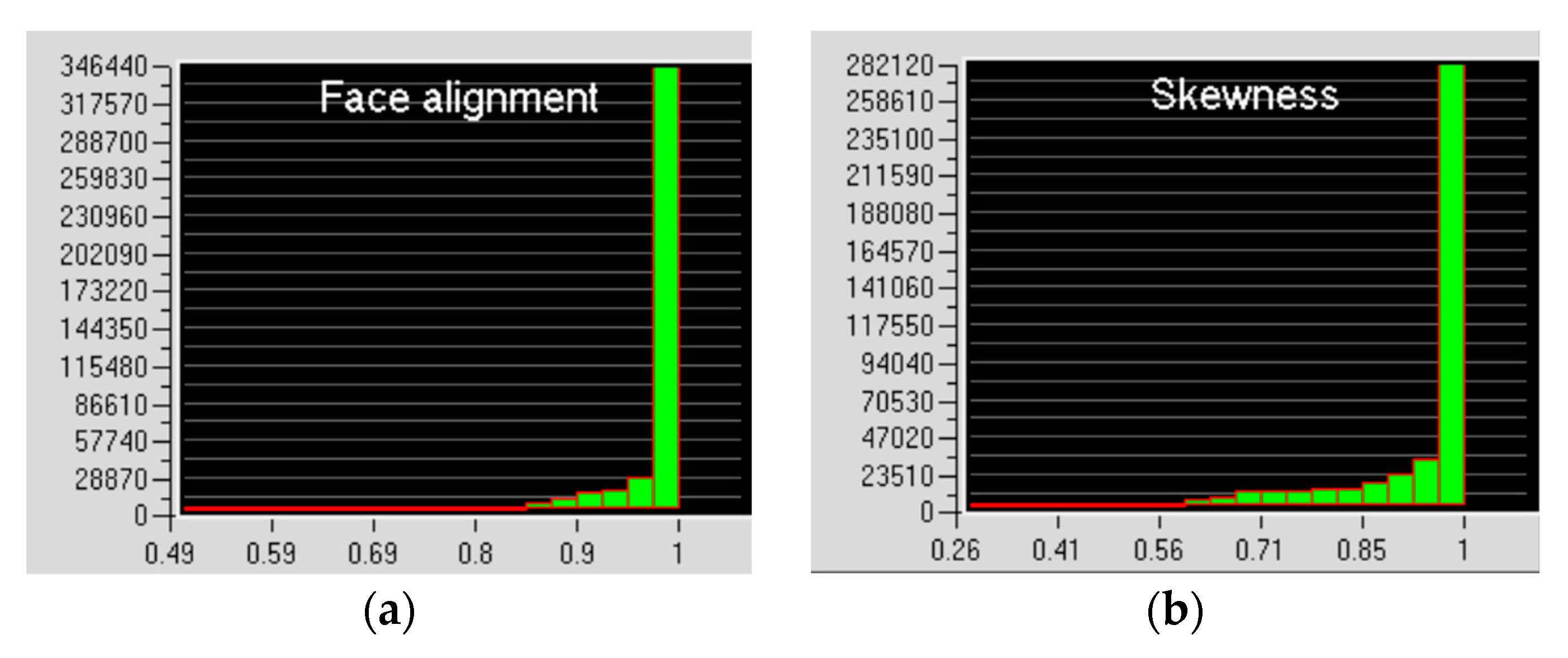
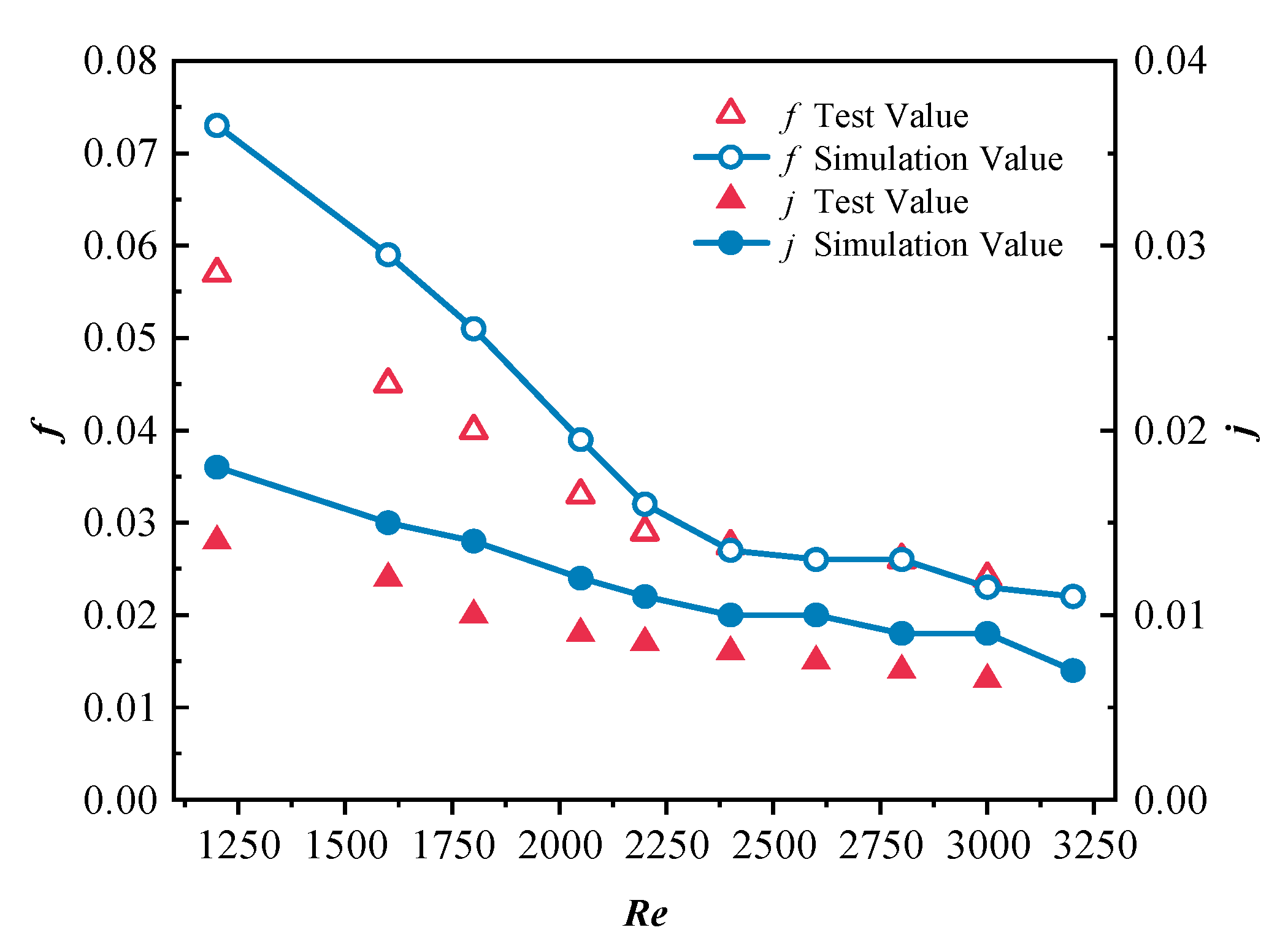
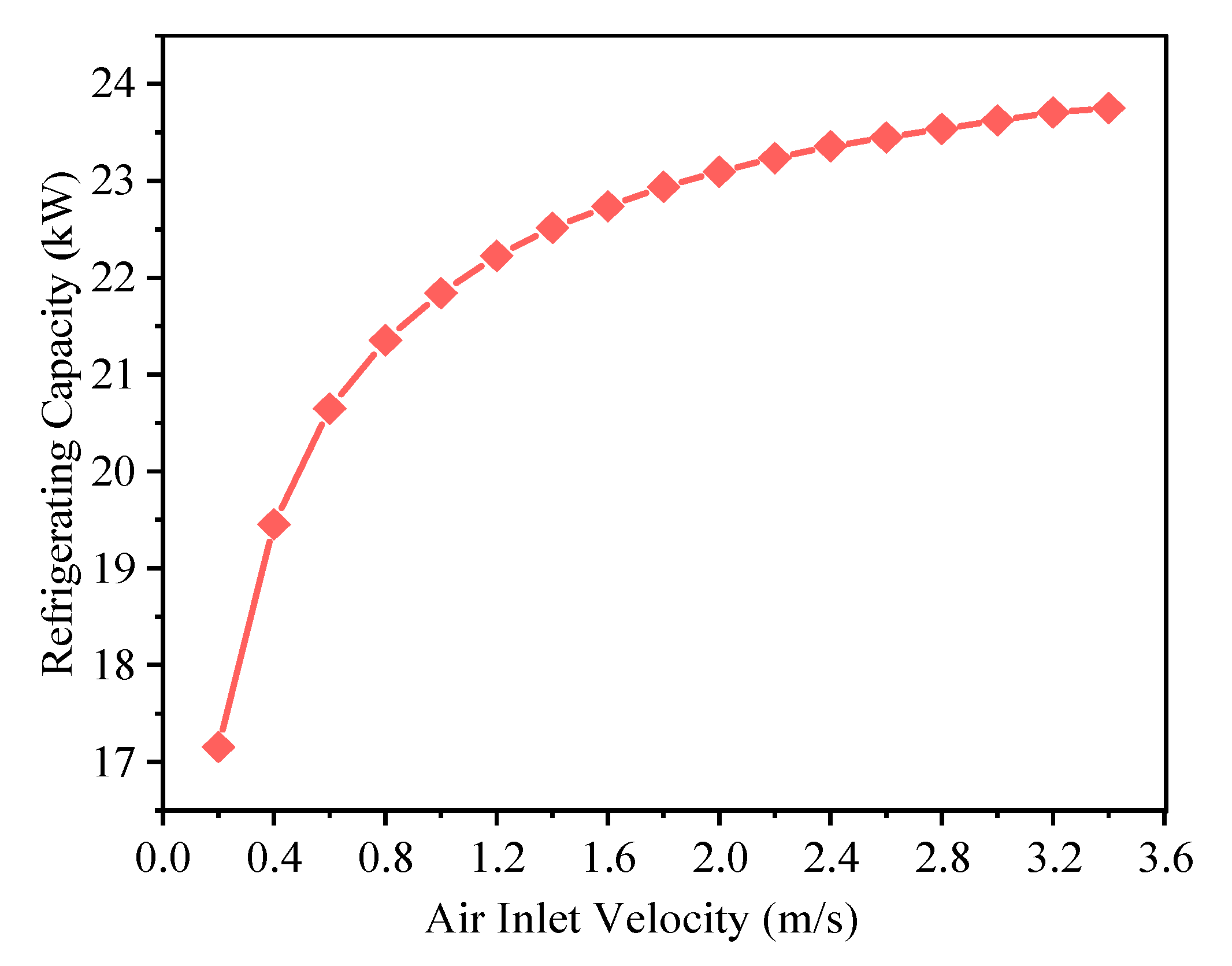
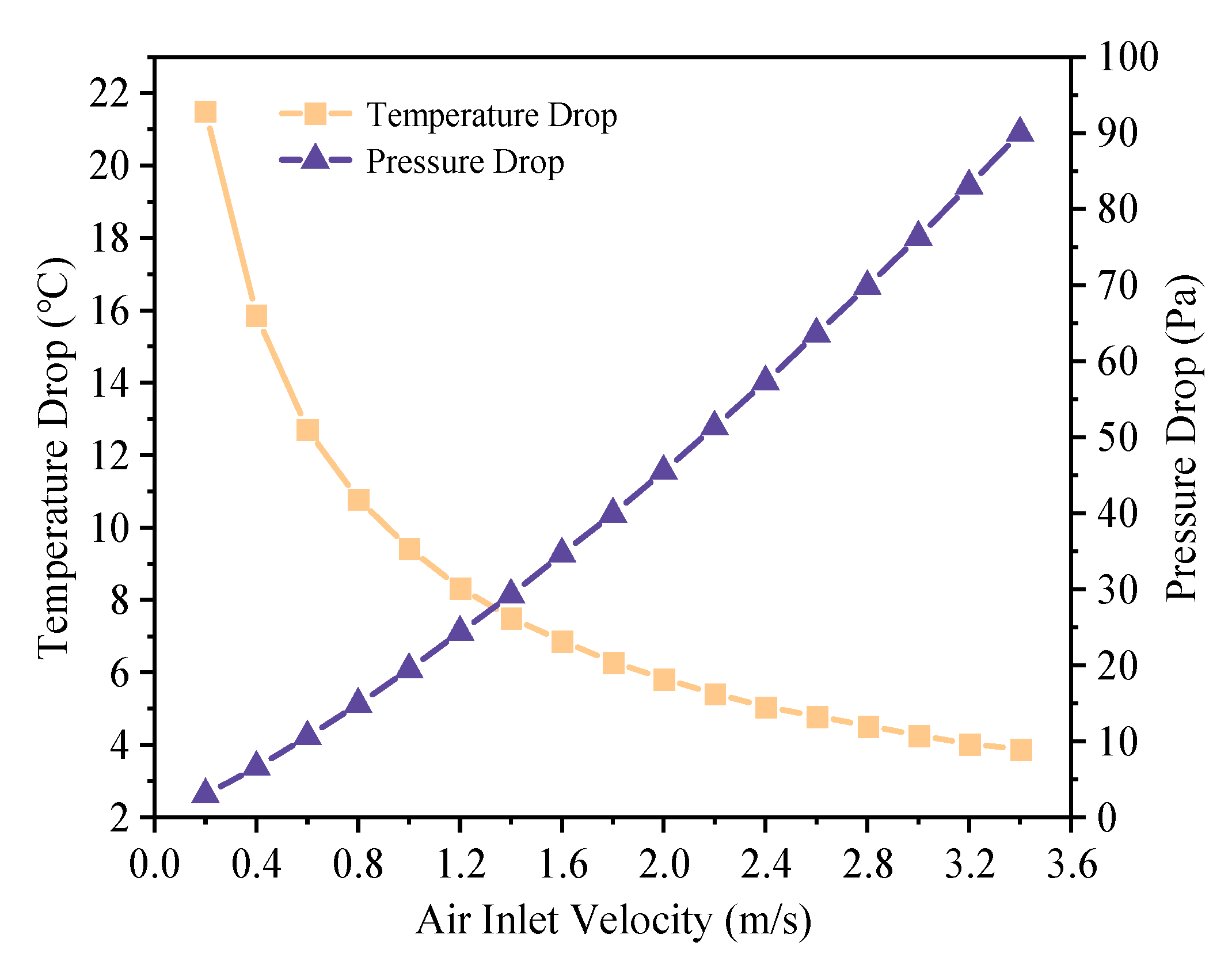
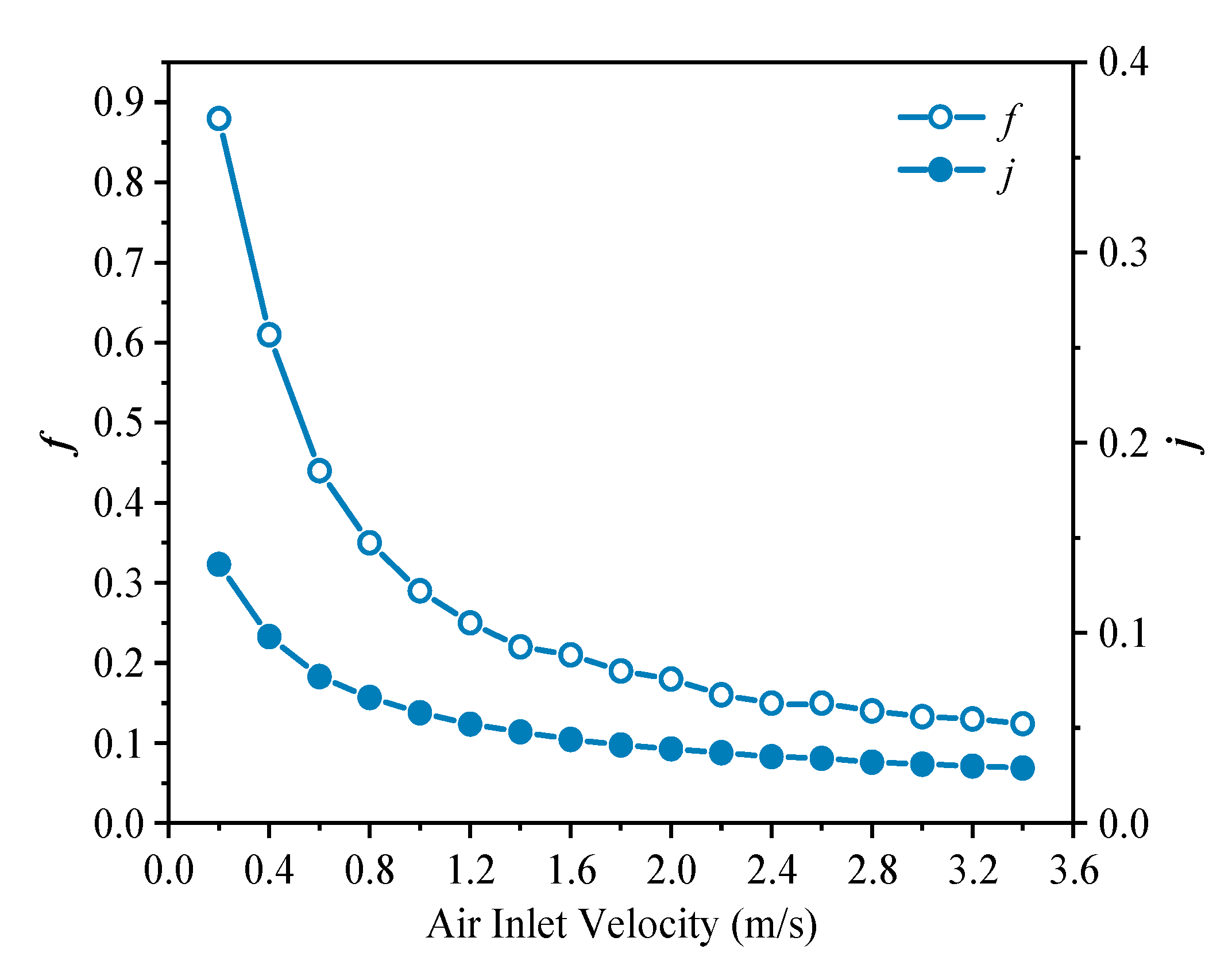


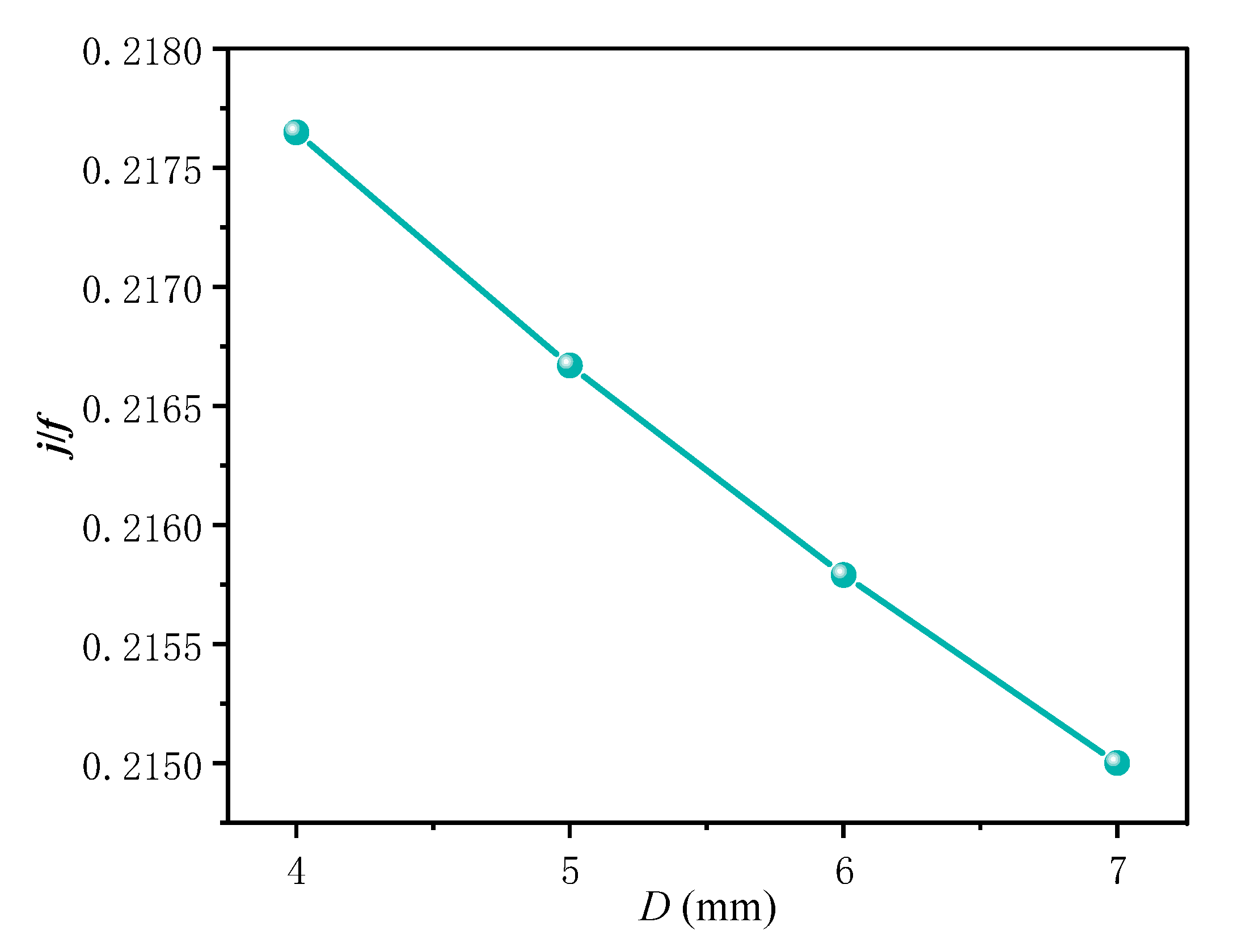
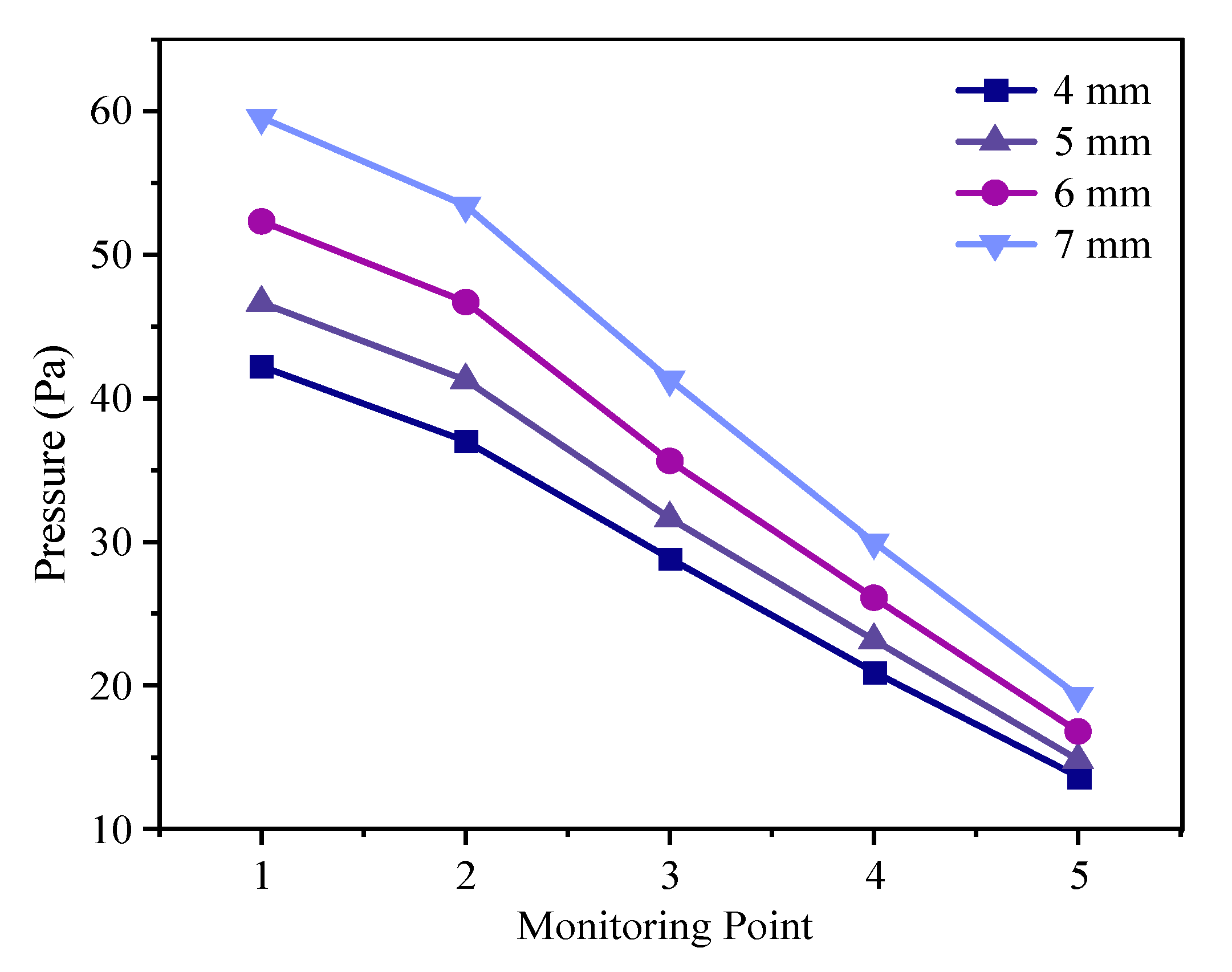
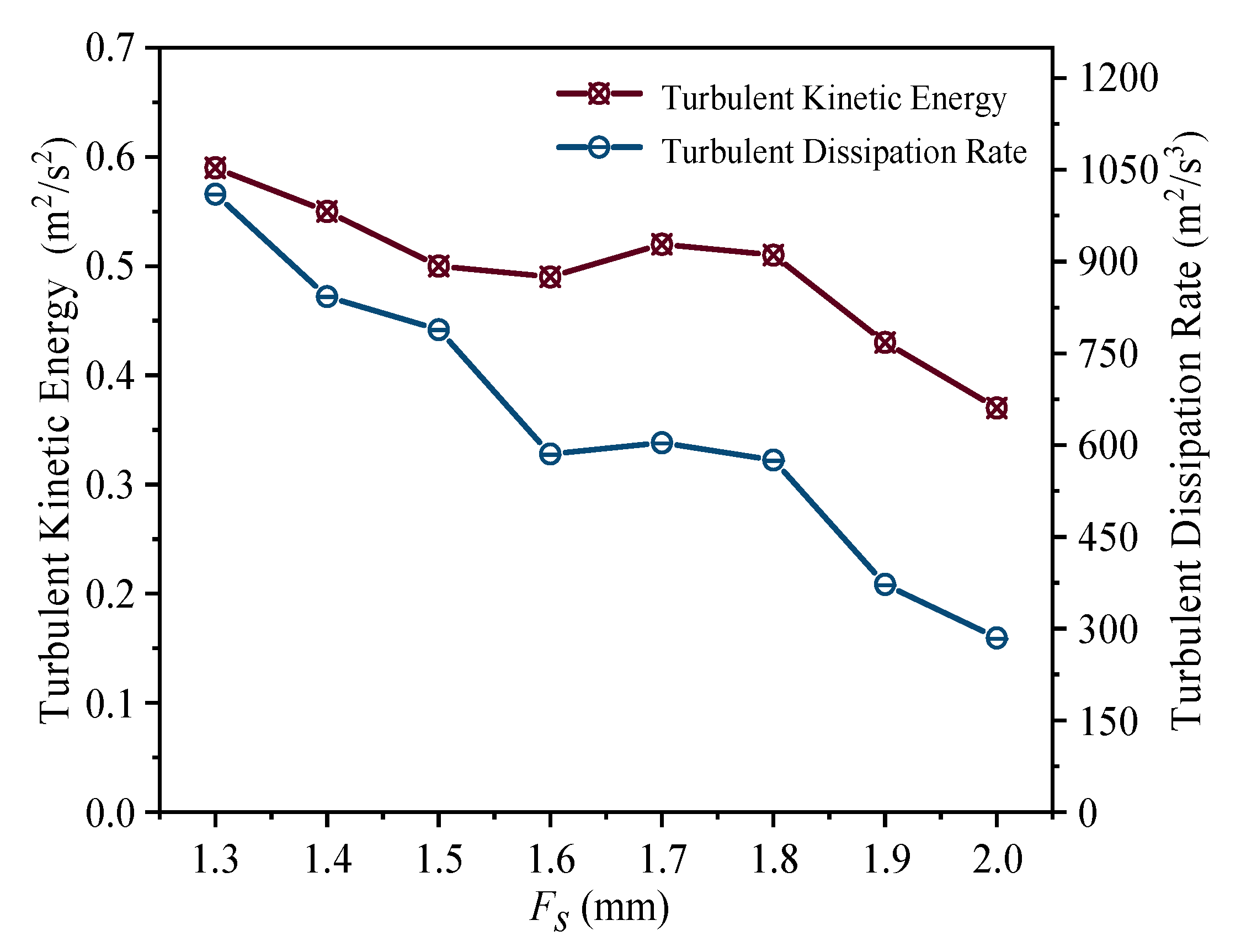
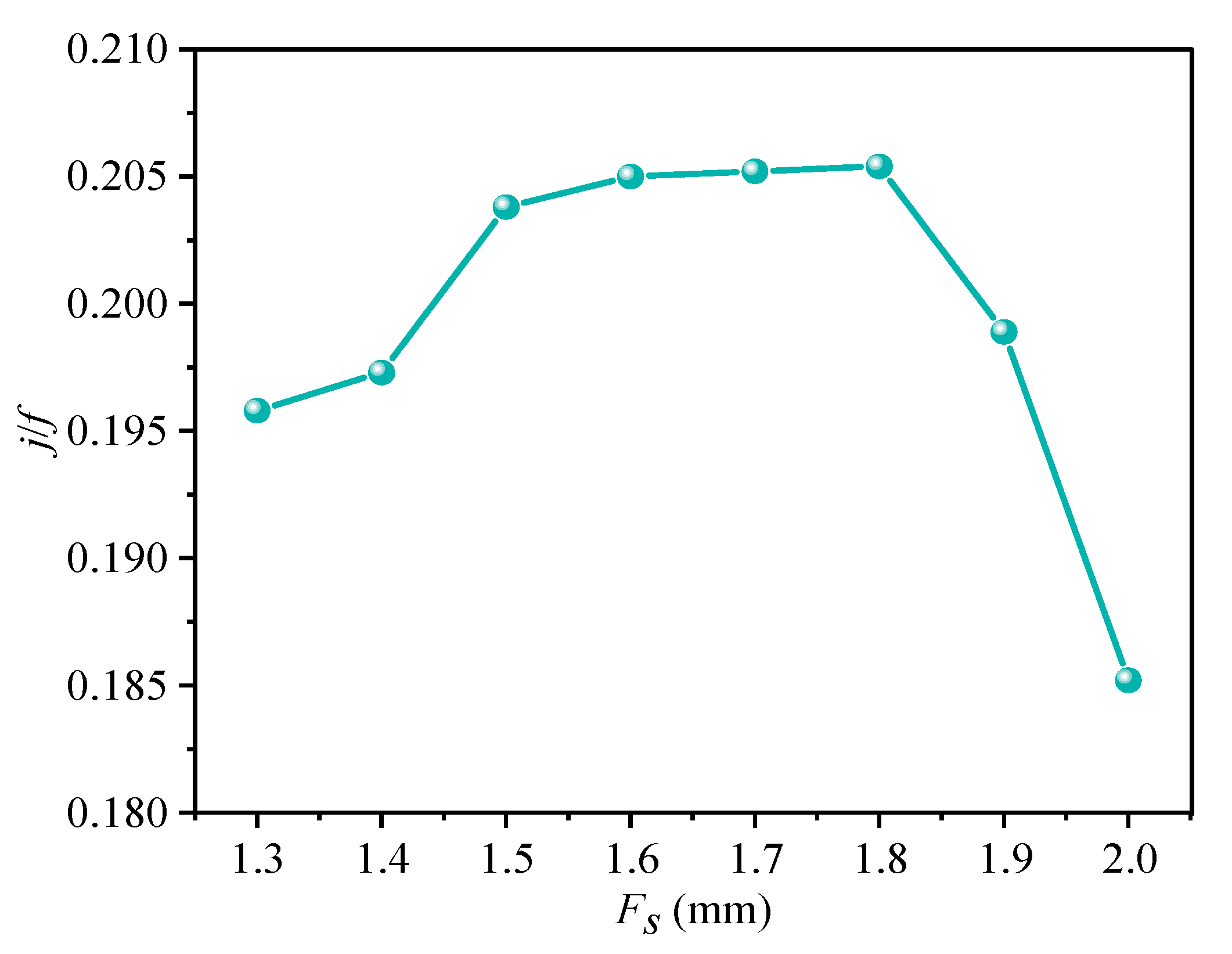
| R12 | R22 | R134 a | R407 c | R290 | R744 c | |
|---|---|---|---|---|---|---|
| Ozone Depletion Potential/Global Warming Potential | 1/8500 | 0.05/1700 | 0/1300 | 0/1600 | 0/3 | 0/1 |
| Molecular Weight (kg/kmol) | 120.9 | 86.5 | 102.0 | 86.2 | 44.1 | 44.0 |
| Normal Boiling Point (°C) | −29.8 | −40.8 | −26.2 | −43.8 | −42.1 | −78.4 |
| Critical Pressure (MPa) | 4.11 | 4.97 | 4.07 | 4.64 | 4.25 | 7.38 |
| Critical Temperature (°C) | 112.0 | 96.0 | 101.1 | 86.1 | 96.7 | 31.1 |
| Specific Pressure a | 0.07 | 0.10 | 0.07 | 0.11 | 0.11 | 0.47 |
| Specific Temperature b | 0.71 | 0.74 | 0.73 | 0.76 | 0.74 | 0.90 |
| Unit Volume Refrigerating Effect (kJ/m3) | 2734 | 4356 | 2868 | 4029 | 3907 | 22,545 |
| Parameter | Value | Parameter | Value |
|---|---|---|---|
| Evaporator Length L | 1400 mm | Transverse Spacing of Tube S2 | 12.7 mm |
| Evaporator Width W | 67 mm | Number of Tube Rows N | 5 |
| Evaporator Height H | 441.5 mm | Number of Tubes Per Row n | 23 |
| Tube Inner Diameter D0 | 4.4 mm | Fin Type | Flat |
| Tube Outside Diameter D | 5.0 mm | Fin Thickness Ft | 0.14 mm |
| Longitudinal Spacing of Tube S1 | 19.05 mm | Fin Spacing Fs | 1.7 mm |
| Parameter | Value |
|---|---|
| Ambient Air Temperature/°C | 35 |
| Influence of Air Relative Humidity/% | 50 |
| Mixed Air Temperature/°C | 31.7 |
| Relative Humidity of Mixed Air/% | 42 |
| Refrigerant | R744 (CO2) |
| Evaporation Temperature of Refrigerant/°C | −7 |
| Total Cooling Capacity of The Evaporator/kW | 22.5 |
| Re | 1200 | 1600 | 1800 | 2100 | 2200 | 2400 | 2600 | 2800 | 3000 | 3200 |
|---|---|---|---|---|---|---|---|---|---|---|
| f Test Value | 0.057 | 0.045 | 0.04 | 0.033 | 0.029 | 0.0275 | / | 0.026 | 0.024 | / |
| f Simulation Value | 0.073 | 0.059 | 0.051 | 0.039 | 0.032 | 0.027 | 0.026 | 0.026 | 0.023 | 0.022 |
| j Test Value | 0.014 | 0.012 | 0.010 | 0.009 | 0.0085 | 0.008 | 0.0075 | 0.007 | 0.0065 | / |
| j Simulation Value | 0.018 | 0.016 | 0.014 | 0.012 | 0.011 | 0.010 | 0.010 | 0.009 | 0.009 | 0.007 |
| f Root Mean Square Error | 0.88% | |||||||||
| j Root Mean Square Error | 0.31% | |||||||||
| Outer Diameter of Tube/mm | 4 | 5 | 6 | 7 |
|---|---|---|---|---|
| Temperature Drop/°C | 5.44 | 5.83 | 6.26 | 6.96 |
| Turbulent Kinetic Energy/m2·s−2 | 0.56 | 0.58 | 0.61 | 0.67 |
| Turbulent Dissipation Rate/m2·s−3 | 803.81 | 839.24 | 900.71 | 1008.59 |
| Heatsink Transfer Factor j | 0.037 | 0.039 | 0.041 | 0.043 |
| Resistance Coefficient f | 0.17 | 0.18 | 0.19 | 0.20 |
| Refrigerating Capacity/kW | 23.64 | 23.09 | 22.39 | 21.99 |
| Fs/mm | 1.3 | 1.4 | 1.5 | 1.6 | 1.7 | 1.8 | 1.9 | 2.0 |
|---|---|---|---|---|---|---|---|---|
| Average Outlet Air Temperature/°C | 25.92 | 25.93 | 25.90 | 25.85 | 25.85 | 25.88 | 25.78 | 25.79 |
| Pressure Drop/Pa | 81.16 | 71.80 | 61.13 | 58.09 | 48.63 | 48.91 | 45.00 | 42.09 |
| Turbulent Kinetic Energy/m2·s−2 | 0.59 | 0.55 | 0.50 | 0.49 | 0.52 | 0.51 | 0.43 | 0.37 |
| Turbulent Dissipation Rate/m2·s−3 | 1010.34 | 842.78 | 788.95 | 585.76 | 603.83 | 575.87 | 372.42 | 284.80 |
| Heatsink Transfer Factor j | 0.047 | 0.045 | 0.043 | 0.041 | 0.039 | 0.038 | 0.037 | 0.035 |
| Resistance Coefficient f | 0.240 | 0.228 | 0.211 | 0.200 | 0.190 | 0.185 | 0.186 | 0.189 |
| Refrigerating Capacity/kW | 29.76 | 27.74 | 25.96 | 24.41 | 23.07 | 22.01 | 20.89 | 20.08 |
Disclaimer/Publisher’s Note: The statements, opinions and data contained in all publications are solely those of the individual author(s) and contributor(s) and not of MDPI and/or the editor(s). MDPI and/or the editor(s) disclaim responsibility for any injury to people or property resulting from any ideas, methods, instructions or products referred to in the content. |
© 2023 by the authors. Licensee MDPI, Basel, Switzerland. This article is an open access article distributed under the terms and conditions of the Creative Commons Attribution (CC BY) license (https://creativecommons.org/licenses/by/4.0/).
Share and Cite
Cui, H.; Su, X.; Guan, Y.; Fei, J. CFD Simulation Study on the Air Side of a CO2 Evaporator in a Motor Train Unit Air Conditioning System. Energies 2023, 16, 1037. https://doi.org/10.3390/en16031037
Cui H, Su X, Guan Y, Fei J. CFD Simulation Study on the Air Side of a CO2 Evaporator in a Motor Train Unit Air Conditioning System. Energies. 2023; 16(3):1037. https://doi.org/10.3390/en16031037
Chicago/Turabian StyleCui, Hongjiang, Xiaoke Su, Ying Guan, and Jiyou Fei. 2023. "CFD Simulation Study on the Air Side of a CO2 Evaporator in a Motor Train Unit Air Conditioning System" Energies 16, no. 3: 1037. https://doi.org/10.3390/en16031037
APA StyleCui, H., Su, X., Guan, Y., & Fei, J. (2023). CFD Simulation Study on the Air Side of a CO2 Evaporator in a Motor Train Unit Air Conditioning System. Energies, 16(3), 1037. https://doi.org/10.3390/en16031037





